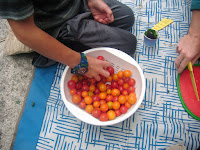
the more you eat the more you toot!
Not only is this a funny chant, it is also quite true. There are bacteria in our bodies that help to break down the beans we eat. Well, as the bacteria do this they create gas which leaves our body. We didn't eat beans today but we did use them to make mosaic pictures to take home. Our bean teepee gave us lots of beans. Some were ready to pop in our mouths, others were already dried on the vine.
Last class while learning about herbs, we happened upon a giant pickling cucumber growing in the garden. One student thought it would be so awesome if we could pickle it. So I found the largest jar possible and popped the cuke in along with vinegar, pickling salt, garlic, and dill. Voila....a giant pickle! It was really sour and everyone's face was puckered.
 |
| Puckered Faces |
There was some friendly competition playing "Name the Part of the Plant We Eat" for lack of a shorter name. Students were showed a picture of a vegetable and then buzzed in to answer what part of the plant we eat. For instance if you have celery you are eating the stem of the plant.
 The big surprise for class was cooking a pasta meal right their in the garden. The students harvested tomatoes galore. They used a food mill to remove all the seeds and skins from the tomato fruits. Other food harvested for the sauce was basil, parsley, thyme, onion, and garlic. Amazing to think we grew everything we needed to make pasta sauce.
The big surprise for class was cooking a pasta meal right their in the garden. The students harvested tomatoes galore. They used a food mill to remove all the seeds and skins from the tomato fruits. Other food harvested for the sauce was basil, parsley, thyme, onion, and garlic. Amazing to think we grew everything we needed to make pasta sauce.  |
| Listening to the story Jack and the Beanstalk |
























